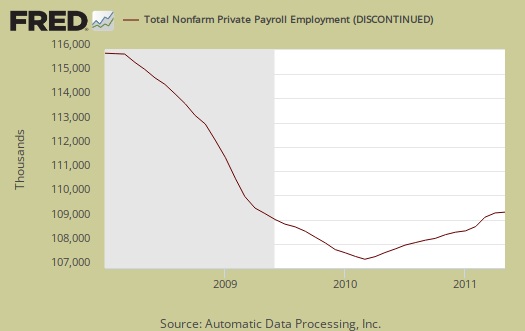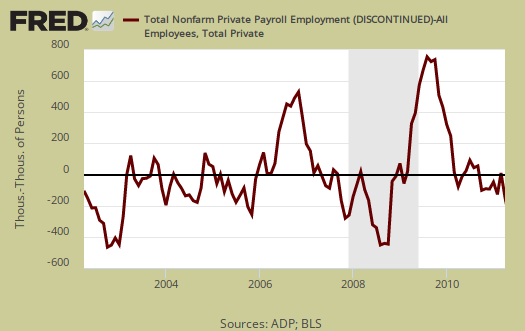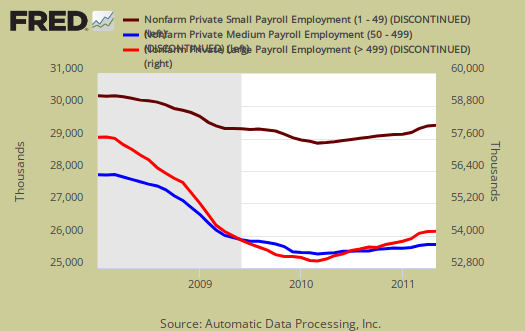ADP, a private organization, released their private payrolls jobs report. This month ADP is reporting a gain of 38,000 private sector jobs in May 2011. This is a very sharp deceleration of job growth. Below are the reported private sector jobs from ADP. This report does not include government, or public jobs.

ADP is reporting the service sector created 48,000 jobs while the goods sector lost 10,000 jobs. The ADP tab on manufacturing is down 9,000 jobs for the month. 6,000 jobs were lost in financial services as well. This correlations to the recent initial unemployment claims reports, which spiked up past 400,000, and are staying there.
Construction dropped 8,000 jobs and the ADP notes over 2 million construction jobs have been lost since the start of the Great Recession.
We take the ADP report with a grain of salt, especially on a monthly basis. Why? Because there is a mismatch against the BLS jobs report. To date, the number of private nonfarm payroll jobs ADP reports versus what the BLS reports and on a month-to-month and even cumulative basis don't match. This monthly error is often large, especially when looking at small job growth overall (< 400,000 jobs per month) on a month to month basis.
Below is the cumulative difference between what the ADP reports as the private nonfarm payroll jobs vs. the BLS (ADP minus BLS). This line shows the divergence, over time in number of nonfarm private payroll jobs reported between the two reports. This post will updated to include the May BLS numbers when released on Friday.

While ADP notes a simple correlation of 0.95, well, a 5% error between monthly reported jobs numbers is an average, and we can see on some months the differences are quite large and around 2008, the difference started to hit about 900,000 jobs.
ADP does use the same seasonal adjustment as the BLS, but their other methodology and even sampling size are different, is proprietary and also seems to change from month to month. Generally the ADP claims their sample size is at least twice as large as the BLS current employment statistics survey. The ADP does not incorporate a birth/death model, although they do categorize jobs by the NAICS codes, the same as the BLS.
Bottom line, the official report, upon which other metrics are based, is the BLS. Additionally, since the BLS is our government, we get to find out exactly what methods and models they use, unlike ADP.
All of this said, the reality is the The United States currently needs about 10.7 million jobs to get back to pre-recession levels, taking into account population growth and the labor participation rate back in December 2007. Anyone jumping all over themselves over < 200,000 jobs added in one month, at minimum, isn't taking population growth into account and is experiencing wishes and dreams instead of what's true.
There is one thing to note that is worth looking at, especially due to it's relativity within the same report (and methods). ADP reports on large vs. medium vs. small businesses and their job creation per business size. In May:
Employment among large businesses, defined as those with 500 or more workers, decreased by 19,000, while employment among medium-size businesses, defined as those with between 50 and 499 workers, increased by 30,000. Employment for small businesses, defined as those with fewer than 50 workers, rose 27,000 in May.*
Below is the graph of ADP private sector job creation breakdown of large businesses (bright red), median business (blue) and small business (dark red). For large business jobs, the scale is on the right of the graph. Medium and Small businesses scale is on the left.
Notice how large businesses have been declining and the pattern starts just about the time offshore outsourcing and the China PNTR came into effect. Small businesses, on the other hand, have increased employment. May I suggest that small businesses are not international, they are not signing offshore outsourcing contracts and moving jobs to India and China. Multinationals, on the other hand, the below decade trend line clearly shows these so called U.S. corporations have abandoned the U.S. worker, on whole. Earlier, the BEA reported statistics validating the ADP job creation trends by business size.

April 2011 ADP private sector jobs were revised doward, from 179,000 to 177,000. ADP also is in sync with the BLS on the bottoming and millions of jobs lost in construction.

folks, remind me to update this ADP vs. BLS graph on Friday
Sometimes the ADP has really diverged, although I suspect, strongly, we're going to get a crappy employment report on Friday due to initial unemployment claims being above 400k plus some of the GDP numbers coming in that eventually will make up Q2 GDP are looking horrific.
jobs trends, jobs per 1000 people
indeed.com has a good site, job trends from their database.
Now on tech jobs, I can tell you companies will put out tons of ads with no intention to hire.
They are looking for specialty skills and it gets so exacting, they will put out an absurd amount of ads, so one needs to look at the actual growth in jobs for that region as well as occupational jobs.
They also are notorious to use ads to simply import foreign workers instead of giving a U.S. worker even a shot. It's just a legal maneuver to offshore outsource your job de facto.
Can't Wait to Hear The Excuses
So one way or the other, you think the report's going to be bad.
I guess there will be silence or the usual empty rhetoric from Obama on down.
After the election Bernancke started speaking up about the full employment not returning for about 5+ years. Haven't heard anything like that from him or anybody else in months.
chicago Fed - 10%-25% of unemployment rate drop, people dropping
The Chicago Fed just did an analysis claiming 10%-25% of the unemployment rate drop can be attributed to people falling off of the count, running out of benefits.
I didn't post it because I needed to check their assumptions. Seems low actually, but bottom line people not being able to find a job and falling off of the count eventually is one of the reasons the unemployment rate has dropped.
Most of it is labor participation rate, as well as population growth assumptions...
The real thing to look at is the actual number of payroll jobs created.
But I'm sure we'll hear "weather" or all sorts of crap or we might get a solid unemployment report, I don't know.
I'll be pouring all over it to be sure tomorrow. But bottom line, even with a blow out, we have a jobs crisis.
I expect to see something like 60k or so jobs created and I expect the unemployment rate to drop, but only due to the above factors, not actual jobs created.
Will Obama Have Worst 2nd Term Since FDR?
The thought occurred to me after reading what you wrote:
Why is Obama pushing everything about unemployment down the road -- when he expects to be in the White House when it all hits?
The unemployment crisis will manifest itself far sooner than later compared to Medicare, Social Security, deficit, or defense spending. Surely there's soon going to be a year more than a million dead broke unemployed and their families will end up on their relatives' doorsteps. Each spring since 2009 millions more new school graduates have been able to find a fulltime job (or even parttime job) and have become all but permanent guests at Hotel of Mom and Dad. Plus eventually there's lots of homeowners who will end up losing their house and/or go bankrupt.
Seriously, can't you just picture that by 2014 the millions of miserable Americans screaming at each other at home will also be screaming at images of President Obama, too, whenever he appear on the television set?
That would apply to other prominent politicians of both parties. Where's their self-preservation instincts?